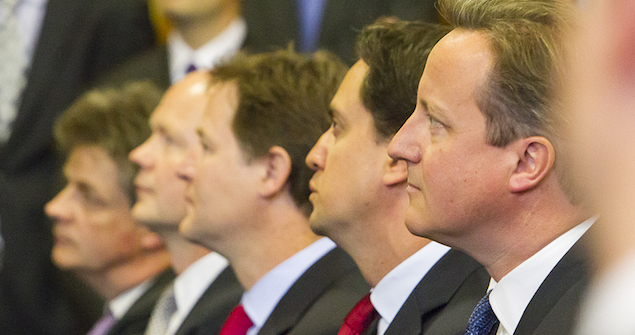It Remains Up in the Air Who Will Lead Britain’s Next Government

The UK election – clarity, or fuzzy power sharing?
On the morning of 7th May 2015, Britain will wake up to its second consecutive inconclusive General Election. In 2010, despite the lingering expectation that political gravity would see the Conservatives win a majority, a coalition government made up of David Cameron’s party and the smaller, centrist, Liberal Democrats – led by Nick Clegg – was announced. Despite a token attempt, there was neither the numbers nor the political will at the time to create a ‘rainbow coalition’ – of Labour, the Liberal Democrats, the Scottish Nationalists, Plaid Cymru, the SDLP and a solitary Green MP – the only other viable potential government on the table.
It represented the first time that two parties had cohabited in government since 1922 outside of wartime and it understandably came as a surprise to a media and public unfamiliar with political plurality. What has come as an even greater surprise is that, despite repeated predictions of its demise, it has lasted the entire duration of a fixed-term five-year parliament. As Britain’s two-party duopoly continues to fragment, the country’s experiment with multi-party government looks set, in one way or another, to continue until and perhaps beyond 2020.
At the time of writing, Labour and the Conservatives both sit in the low to mid 30s in the polls and discussion has turned to what kind of government may emerge from multiple rounds of negotiation following an inconclusive result. In this context, the unwritten rules of election dialogue surrounding electoral ‘victory’ and ‘defeat’ have been rewritten to take account of the potential pacts available to both main parties.
While much has been written over the past two years or so about the rise of smaller parties, such as Nigel Farage’s UKIP and the Green Party (led by the Sydney-born Natalie Bennett), even optimistic scenarios see neither party looking likely to win more than two or three seats apiece. Rather, their impact seems to be in depriving the larger parties of votes and therefore seats. In the absence of a proportional voting system, Britain’s more radical parties look set to play only a peripheral role in the formation of the next government, despite their impressive polling gains during the course of the current parliament.
Coalition continuation
The Conservatives are currently favoured to emerge as the largest party by the academic experts who run electionforecast.co.uk. Their model takes into account previous election results, constituency characteristics and aggregate polling and can be trusted to produce a reliable snapshot of the current state of play. However, the prospect of them gaining any seats – let alone enough to form a majority government – looks slim. More realistic is the possibility of the current Conservative-Liberal Democrat coalition continuing into a second term, but their seats total looks likely to fall short of the magic figure of 326.
A further impediment to what has been described as “coalition 2.0” is that Conservative backbench MPs – generally to the right of their leader – may be reluctant to endorse a continuation of a government that many of them have found unsatisfactory. Smaller, right-wing parties, such as the Northern Irish Democratic Unionist Party, may be brought into the fold, though the Liberal Democrats have ruled out working with UKIP (and may find some of the DUP’s views on homosexuality, for example, unpalatable). Although Cameron’s party is very much in contention to remain the largest party, their continued presence in Government is in real jeopardy as polling day draws closer.
A unionist-separatist marriage
The Labour Party would appear to be in a stronger starting position. Though it too is unlikely to be in a majority, it has more natural allies in a putative post-election House of Commons than the Conservatives. For example, the Scottish National Party – set to rout Labour north of the border – has ruled out doing any kind of deal with Cameron’s party, even going so far as to pledge to ‘lock the Conservatives out of Downing Street’.
In the two election debates (one featuring Cameron, Miliband, Clegg,’s Nigel Farage, Plaid Cymru’s Leanne Wood, and the SNP’s Nicola Sturgeon) it was the SNP leader who came out on top. Indeed, Sturgeon has even managed to achieve a degree of popularity for herself amongst sections of England’s left-leaning voters.
It is likely that, combined, Labour and the SNP would have enough MPs to allow the Labour leader Ed Miliband to form a minority government with the “confidence and supply” support of the SNP and perhaps a smattering of smaller parties (such as the Greens, the Welsh nationalist Plaid Cymru and the Northern Irish SDLP). While this arrangement would be potentially messy, the parties each to varying degrees share a left-wing political outlook and, crucially, an antipathy to the Conservatives. It may be this reality that decides the identity of the next government.
Conclusion
Ultimately, who holds power over the election will come down to which single party has the largest number of seats and whether a politically and ideologically coherent ‘bloc’ can be assembled in a divided and fragmented House of Commons. The rules in a parliamentary democracy such as the UK’s are relatively straightforward – whichever candidate for Prime Minister can command the support of the House of Commons can form a government. There is little to prevent the party which finishes second forming a government, provided that there are enough MPs willing to support them. It is in this context that the Conservatives’ concerted campaign to paint a Labour/SNP arrangement as chaotic and illegitimate, must be seen.
This gambit may yet work, and provided that the Conservatives do – in line with the electionforecast.co.uk team’s prediction – manage to retain their status as the largest party, we could see a continuation of the current coalition. However, it looks equally likely to be a minority Labour government, supported by the SNP and an assortment of smaller, left-leaning and anti-Conservative parties.
In this context, it is little surprise that the Conservatives are seeking to rewrite the rules to cast a light of ‘illegitimacy’ on any arrangement between the two. UK elections tend to be settled on Election Day. This one may rumble on for weeks.
Sean Kippin is the Managing Editor of Democratic Audit UK based at the London School of Economics and Political Science. This article can be republished with attribution under a Creative Commons Licence.





